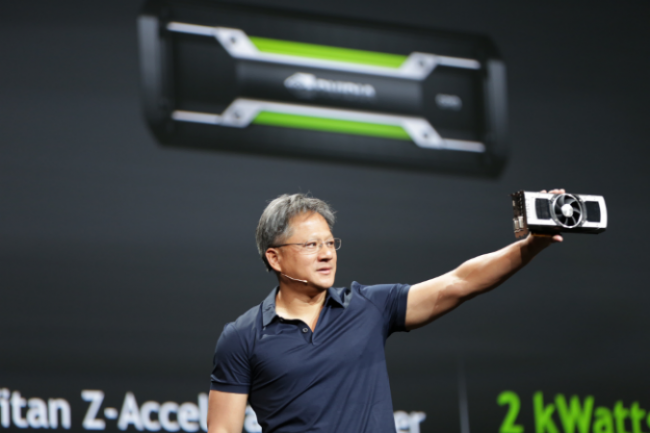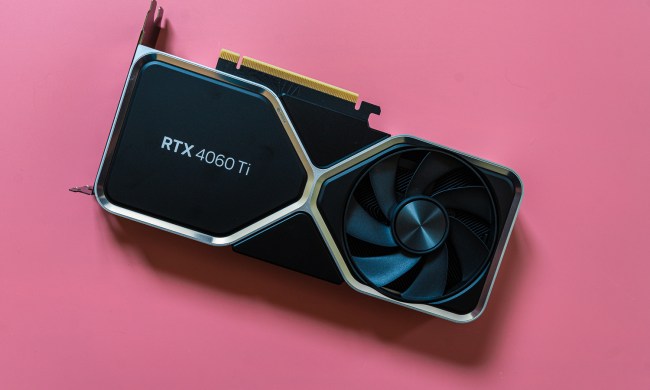
Last week, at Nvidia’s GPU Technology Conference, the company took the wraps off of a few interesting new products and technologies, including its upcoming Pascal GPU architecture, which should make 2016 interesting for PC gamers. They also showed off the $192 Jetson development platform, a sort of super-charged Raspberry Pi that’s based on the company’s next-gen K1 mobile chip first announced at CES 2014.
But the announcement that really put fear into the wallets of enthusiast gamers everywhere was the next iteration of the company’s flagship consumer graphics card, the GeForce GTX Titan Z. The original Titan, which was priced at $999 when it launched a little over a year ago, was already a stunningly expensive card. The company recently updated that product with the GTX Titan Black, which thankfully stuck to the Titan’s $999 price point.
It’s likely that the Titan Z’s $3,000 price point is an attempt to balance consumer cost with professional demand.
But clearly, Nvidia thinks that there’s room for a more powerful, much higher-priced single card solution to our high-end graphics and GPU compute needs. To that end, the company took two GK110 GPUs (the chip at the heart of the GTX Titan Black), tweaked them to run as well as possible together in a single card, slapped a jaw-dropping $3,000 price tag on the resulting board, and called it the GTX Titan Z.
We still don’t know all the details about the Titan Z; it isn’t for sale yet, and Nvidia likely wants to save the finer minutiae for reviewers to uncover when the card officially goes on sale. However, Nvidia did say that the Titan Z will feature the same 7GHz GDDR5 video memory as the Titan Black and GTX 780 Ti cards, running across two 384-bit buses. Plus, because the card is essentially two GTX Titan Blacks in one, there will be a massive 12GB of that speedy memory on the board.
As a long-time video card reviewer, I’m not easily impressed by high-end hardware. But the Titan Z’s specs, as well as its $3,000 price tag, make it easy to peg as just plain crazy. For most of us, it clearly is, but for a select few well-heeled potential buyers, it also makes a crazy kind of sense. As nuts as $3,000 sounds for a graphics card that melds two $1,000 cards together, there’s a good reason why Nvidia priced the Titan Z that way as well.
Gamers
Even if you’re an enthusiast gamer who would consider dropping $3,000 on a graphics card like the Titan Z, there are probably smarter options out there. For instance, Nvidia’s very own GeForce GTX 780 Ti is based around the same GK110 chip that is doubled up in the Titan Z—and it’s priced at a relatively inexpensive $699. So if your PC’s case has the space for multiple graphics cards, you could drop in two GTX 780 Ti cards and run them in tandem (SLI) for $1,400. That’s less than half the price of a Titan Z, and you’ll likely get performance results similar to what you’d get with the $3,000 card.
Granted, the Titan Z has more memory, but it’s unlikely that any game in the foreseeable future is going to make good use of 12GB of video RAM. That’s unless you’re planning on doing something crazy, like buying three 4K monitors. Even so, if you want to game at that resolution (11,520×2,160, or nearly 25 million pixels), you’ll probably need two or even three GTX Titan Z cards running together to hit decent frame rates at high settings. If you just spent a few thousand dollars on monitors, you’ve probably got $9,000 laying around to spend on graphics cards, right? Right?
Professionals and content creators
The original GTX Titan, while Nvidia also marketed towards gamers, made a lot of sense for professional designers and content creators as well. $1,000 is pricey for a gaming card, but Nvidia’s professional line of Quadro cards, which have very similar internals (they’re based on the same graphics cores as high-end gaming cards), cost a lot more. The Quadro K6000, which is also based on the GK110 chip in the Titan Black and 780 Ti, currently sells for between $4,000 and $6,000.
For that reason, many creative pros have eagerly snapped up the single-chip Titans at $1,000 a pop. It’s likely, then, that the Titan cards are already noticeably eating into the sales of the costlier Quadro cards. And if Nvidia had priced the Titan Z at $2,000, that would have made professional-class Quadro cards with half the GPU horsepower very hard to justify at roughly 2.5 times the price. So it’s likely that the Titan Z’s $3,000 price point is an attempt to balance consumer cost with professional demand, and not destroy the more lucrative professional graphics card market.
Small form-factor systems
Even at $3,000, the Titan Z is going to be mighty tempting for graphics professionals, especially those who don’t have or don’t want a very large tower tucked under their desk. To a lesser extent, the same goes for gamers as well. As costly as the Titan Z is, boutique PC builders like Falcon Northwest seem to still be shipping plenty of multi-thousand-dollar high-end PCs. On top of that, the market for souped up machines seems to be trending toward smaller towers, where there’s simply no room to drop two—let alone four– GTX 780 Ti cards.
In compact PC cases, there may be room for one or even two GTX Titan Z cards, so you could power that aforementioned triple 4K monitor dream setup even if you don’t have a beastly PC case. No one’s saying that anyone needs that kind of performance, but the Titan Z makes it possible to get that in a more compact system (provided that it also has good cooling) than it was prior to its announcement.
If nearly 20 years of following the enthusiast PC market has taught me anything, it’s that if you can build a PC that offers new levels of performance—regardless of price– someone will be ready and willing to buy it.


